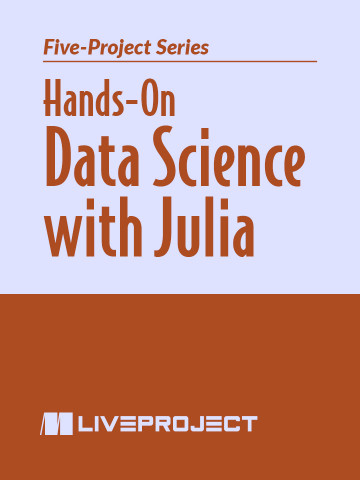- prerequisites
- basics of Julia • intermediate scikit-learn • intermediate data wrangling
- skills learned
- tabular data ingestion and integrity validation • clustering data with k-means and DBSCAN algorithms • calling Python modules from Julia
pro $24.99 per month
- access to all Manning books, MEAPs, liveVideos, liveProjects, and audiobooks!
- choose one free eBook per month to keep
- exclusive 50% discount on all purchases
- renews monthly, pause or cancel renewal anytime
lite $19.99 per month
- access to all Manning books, including MEAPs!
team
5, 10 or 20 seats+ for your team - learn more

In this series of liveProjects you’ll explore the exciting scientific computing language Julia, and tackle common data science tasks with its robust machine learning ecosystem. These insightful and engaging projects work through each stage of a data science pipeline, from data preprocessing to building and training machine learning models. You’ll step into the role of a data scientist for a real estate company and develop hands-on experience with Julia—whether you’re working step by step or dipping into the tasks most relevant to your career.
here's what's included






team
- five seats for your team
- access to all Manning books, MEAPs, liveVideos, liveProjects, and audiobooks!
- choose another free product every time you renew
- choose twelve free products per year
- exclusive 50% discount on all purchases
- renews monthly, pause or cancel renewal anytime
- renews annually, pause or cancel renewal anytime
-
![]() Hands-on Data Science with Julia project for free
Hands-on Data Science with Julia project for free
Prerequisites
This liveProject is for experienced data scientists and data analysts who are interested in building their skills in Julia. To begin this liveProject, you will need to be familiar with the following:
TOOLS
- Basics of Jupyter notebook
- Basics of Julia and intermediate knowledge of another high-level programming language such as Python or R
- Intermediate data wrangling
- Intermediate data visualization
- Basics of bootstrapping
- Basic usage of command pipelines
- Basic usage of functions and control flow
- Basic errors and correlation analysis
 features
features
- Self-paced
- You choose the schedule and decide how much time to invest as you build your project.
- Project roadmap
- Each project is divided into several achievable steps.
- Get Help
- While within the liveProject platform, get help from fellow participants and even more help with paid sessions with our expert mentors.
- Compare with others
- For each step, compare your deliverable to the solutions by the author and other participants.
- book resources
- Get full access to select books for 90 days. Permanent access to excerpts from Manning products are also included, as well as references to other resources.
 Hands-on Data Science with Julia project for free
Hands-on Data Science with Julia project for free